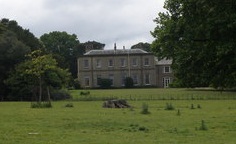
Wassand Hall is a large Regency house situated to the west of Hornsea, East Riding of Yorkshire, England, overlooking Hornsea Mere, which is part of its estate. The hall was designated a Grade II* listed building in March 1952 and is now recorded in the National Heritage List for England, maintained by Historic England. [1] The Hall contains a collection of 18th and 19th Century paintings, English and Continental Silver, furniture, and a collection of porcelain. [2]
Contents
The estate has been in the possession of the Constable family since about 1520. [2] It was rebuilt in 1815 during the Regency period, the original house having been demolished because it had fallen into disrepair. Ownership passed to a widow, Lady Ernestine Strickland-Constable in 1975. Upon her death in 1995, the estate became held by her great-nephew, Rupert Russell, who resides at Wassand Hall with his wife Catherine. [3]
During World War II, the house was requisitioned by the army and was used by the Free French. [3]